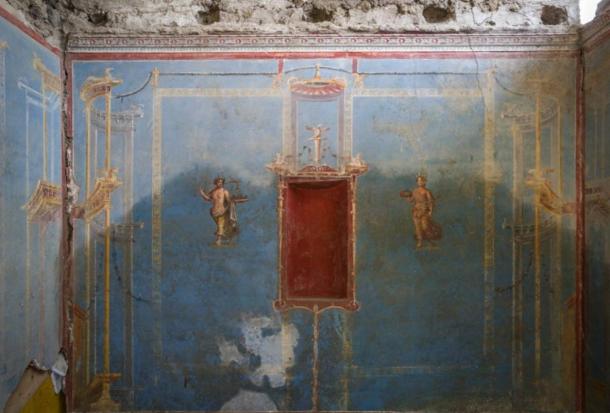🔴 Website 👉 https://u-s-news.com/
Telegram 👉 https://t.me/usnewscom_channel
It’s Pompeii again, the gift that keeps on giving! A series of discoveries over the last 6 months include a pregnant tortoise, children’s graffiti, a painting of flatbread resembling pizza, and frescoes depicting mythological characters associated with the Trojan War. This week, another stunning discovery has made its mark: an opulent Roman shrine with rare blue paint on the walls.
Roman Shrine: A Sacrarium of Roman Worship
The room is thought to be a sacrarium, an ancient Roman shrine where ritual activities took place, and sacred objects were housed. In addition to the blue color, the walls are covered with paintings of women believed to represent the four seasons, or Horea, as per a press release.
Rare ‘blue room’ believed to have functioned as a Roman shrine. ((Italian Ministry of Culture)
The room’s hue is particularly special, as blue “rarely occurs in Pompeian frescoes and was generally used for elaborately decorated rooms,” according to the statement from the Pompeii Archaeological Park. Other walls feature imagery of sheep farming and agriculture, including a plow and a staff used by shepherds and hunters. One of the paintings ‘appears to be a large spotted cat’.
Stunning frescoes found on the walls of the room. (Italian Ministry of Culture)
The discovery was made during recent excavations in Regio IX, a residential area of central Pompeii that is currently “one of the most active excavation sites for new findings,” as per CNN’s Antonia Mortensen and Jessie Gretener. At its peak, Regio IX was home to more than 13,000 rooms spread across 1,070 housing units.
The room measures about 86 square feet (7.98 sq m). Inside, archaeologists found household furnishings and 15 vessels known as amphorae, two bronze jugs, and two bronze lamps. They also uncovered construction materials likely used for renovations and a pile of empty oyster shells, which may have been saved to grind down and add to mortar and plaster, reports ABC News.
The excavation of the blue room is part of a larger project to “safeguard the vast heritage” of Pompeii, which includes 1,070 residential units, as well as public and sacred areas.
Archaeologists discovered household items including 15 amphorae, two bronze jugs, and two bronze lamps. (Bottom right) a pile of oyster shells was uncovered, possibly used as construction materials for renovation. (Italian Ministry of Culture)
Pompeii: A Treasure Chest Still Unexplored!
Gennaro Sangiuliano, Italy’s culture minister, visited Pompeii this week and described the archaeological site as “a treasure chest that is still partly unexplored”. The ancient city is a miracle of preservation: for 2,000 years, volcanic rock and ash from the eruption of Mount Vesuvius in 79 AD kept it frozen in time, quite literally.
By the first century AD, Pompeii was a bustling seaside Roman town on the southwest coast of Italy with an estimated 10,000 to 20,000 inhabitants. Nearby Mount Vesuvius began erupting in late 79, spewing debris and hot, toxic gases over the town. While historians previously dated the disaster to August 24, recent research suggests it may have occurred a few months later.
Eruption of Mount Vesuvius and destruction of Pompeii. (Sunshower Shots / Adobe Stock)
Some residents fled and survived, but around 2,000 Pompeiians were killed in the disaster. The eruption also blanketed other surrounding villages and towns, including Herculaneum. In total, up to 16,000 people are thought to have died.
For hundreds of years, Pompeii remained buried under its volcanic blanket. It was rediscovered in the late 16th century, and researchers have been fascinated with the site ever since. It’s been a UNESCO World Heritage Site since 1997 and continues to welcome archaeologists and travelers from around the world.
In 2018, during a joint operation by the Carabinieri of the Cultural Heritage Protection Center and the Pompeii archaeological superintendence, another stunning discovery was made in a large villa situated just outside the walls of Pompeii, far from the known archaeological area.
Archaeologists at the site uncovered buildings featuring large balconies adorned with Pompeian red colors and geometric decorations of flowers and animals. They named this area the ‘Vicolo dei Balconi’ (Alley of Balconies). It is within this current complex that the aforementioned discovery has been made.
More recently, it was reported that archaeologists in Pompeii had uncovered children’s sketches depicting violent scenes of gladiators and hunters battling animals. These drawings, believed to have been made by children between the ages of five and seven before Mount Vesuvius erupted in 79 AD, were found on the walls of a back room in the residential sector of the archaeological park. The sketches indicate that even children in ancient times were exposed to extreme violence.
Top image: Excavations in Pompeii reveal a rare ‘blue room’ thought to have served as an opulent Roman shrine. Source: Italian Ministry of Culture
By Sahir Pandey




